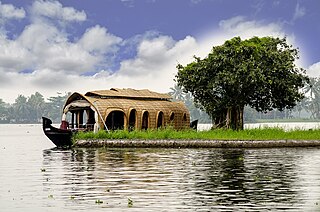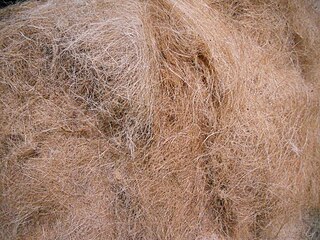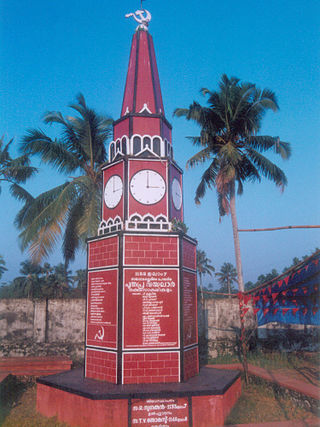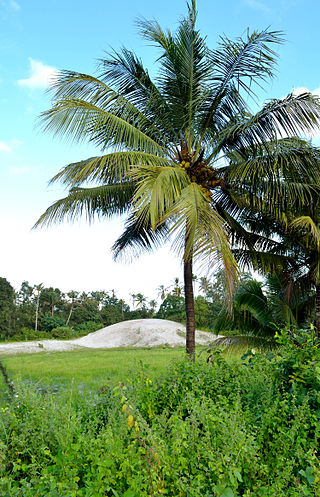
Alappuzha district, is one of the 14 districts in the Indian state of Kerala. It was formed as Alleppey district on 17 August 1957, the name of the district being changed to Alappuzha in 1990. Alappuzha is the smallest district of Kerala. Alleppey town, the district headquarters, was renamed Alappuzha in 2012, even though the anglicised name is still commonly used to describe the town as well as the district.

Kottayam is one of 14 districts in the Indian state of Kerala. Kottayam district comprises six municipal towns: Kottayam, Changanassery, Pala, Erattupetta, Ettumanoor, and Vaikom. It is the only district in Kerala that does not border the Arabian Sea or any other Indian state.

Coir, also called coconut fibre, is a natural fibre extracted from the outer husk of coconut, and used in products such as floor mats, doormats, brushes, and mattresses. Coir is the fibrous material found between the hard, internal shell and the outer coat of a coconut. Other uses of brown coir are in upholstery padding, sacking and horticulture. White coir, harvested from unripe coconuts, is used for making finer brushes, string, rope and fishing nets. It has the advantage of not sinking, so can be used in long lengths in deep water without the added weight dragging down boats and buoys.

The Kerala backwaters are a network of brackish lagoons and canals lying parallel to the Arabian Sea of the Malabar coast of Kerala state in south-western India. It also includes interconnected lakes, rivers, and inlets, a labyrinthine system formed by more than 900 km (560 mi) of waterways, and sometimes compared to bayous. The network includes five large lakes linked by canals, both man made and natural, fed by 38 rivers, and extending virtually half the length of Kerala state. The backwaters were formed by the action of waves and shore currents creating low barrier islands across the mouths of the many rivers flowing down from the Western Ghats range. In the midst of this landscape there are a number of towns and cities, which serve as the starting and end points of backwater cruises. There are 34 backwaters in Kerala. Out of it, 27 are located either closer to Arabian Sea or parallel to the sea. The remaining 7 are inland navigation routes.

K. R. Gouri, born Kalathilparambil Raman Gouri, commonly known as Gouri Amma, was an Indian politician from Alappuzha in central Kerala. She was one of the most prominent leaders of the Left movement in India.

Alappuzha, also known as Alleppey, is the administrative headquarters of Alappuzha district in the state of Kerala, India. The backwaters of Alappuzha are one of the most popular tourist attractions in India which attracts millions of domestic and international tourists.

Kunnathur Kesavan Raman Pillai, also known as Raja Kesavadas was the Dewan of Travancore during the reign of Dharma Raja Karthika Thirunal Rama Varma. He is well known for his military tactics and administrative acumen. He was the mastermind in developing the Alappuzha town.
Mankombu or Moncombu is a village in the district of Alappuzha in the state of Kerala, India. Monkombu, part of the Kuttanad delta region popularly mentioned as 'Rice bowl of Kerala'; is one of the major paddy cultivation regions of the state. Its unique geography embodied by Vembanad lake, inter-linked Pambaa, Manimala and Achenkovil river systems, gives rise to islands, back waters, network of waterways and canals, below sea-level paddy fields and marsh. The farmers here have met the challenges of below sea-level cultivation over two centuries. Annual festivals, auspicious rites and religious events at Mankombu Bhagavathi Devi temple, St.Pius church and Pope John Paul Church are occasions for social communion, rejoicing and celebration. Once a prosperous hamlet of hundreds of households, Mankombu today is ravaged by climate change, pollution and dwindling population.

The Ezhavas are a community with origins in the region of India presently known as Kerala, where in the 2010s they constituted about 23% of the population and were reported to be the largest Hindu community. The Malabar Ezhava group have claimed a higher ranking in the Hindu caste system than do the others, although from the perspective of the colonial and subsequent administrations they were treated as being of similar rank.

The Punnapra-Vayalar uprising was a militant communist movement in the Princely State of Travancore, British India against the Prime Minister, C. P. Ramaswami Iyer and the state. The revolt is named after the two places in which it took place; beginning in Punnapra and ending in Vayalar.
Thumpoly is coastal town in the Alappuzha district, India, and is a well-known Christian Marian pilgrimage shrine of Kerala. Thumpoly church - is a heritage church built by the Portuguese and was established in the year 1600 with stone and wood. Although this church is known in the name of Saint Thomas, it is the Mother of God, Holy Immaculate conception and her festival/ feast that made Thumpoly famous. For the first time in India, the statue of the Mother of God Holy Virgin Mary was enshrined in Thumpoly Church. Even today, Thumpoly Church still following has the traditional/heritage traditional rituals. In 1585 AD, The Confraternity-Visionary Community was established in Thumpoly Church. This church Includes under the Diocese of Alleppey - Roman Catholic Diocese of Alleppey. In the 06th century AD, a few Christians migrated to Thumpoly and established a small thatched church there called "Thomapally". Thus began the Christian tradition of Thumpoly. In AD-820 the bishops of Syria, Mar Sapor and Mar Proth, on their way from Manakodam to Kollam, visited Thumpoly, where the cross established and later the said cross came to be known as "Muthappan Kurish". Thumpoly Church, the second most important church in the Diocese of Alleppey, is expected to receive the status of the second ""Minor Basilica"" in the Diocese. Thumpoly is located at a distance of 80 km from Kochi International Airport, 60 km from Cochin city, 6 km from Alappuzha city, 20 km from Cherthala, 25 km from kuttanadu, 34 km from Changanassery and 52 km from kayamkulam. It is connected to Alappuzha, Arthunkal, Kochi, Ernakulam by road and railway. It is located on the edge of NH 66. The National Highway 66 cuts through the middle of the town. The Arabian Sea is on one side, and a small lake on the other, with the beach of Chakara in Kerala. It is a natural habitat of many rare birds. Thumpoly is known for its canals, which end their course in the Arabian Sea. There are fishing villages on the beaches. The local population are also involved in coir making. Thumpoly is located on the border of Alappuzha Municipality. Thumpoly shares border with Alappuzha Municipality and Aryad Grama Panchayat. Thumpoly church is the largest landmark of Thumpoli.

Thycattusserry is a village in the Cherthala taluk of the Alappuzha district in the Indian state of Kerala.

The West Coast Canal or National Waterway No 3 is a 205 km (127 mi) long inland navigational route located in Kerala, India, which runs from Kollam to Kottapuram. It was declared a National Waterway in 1993. In addition to the main stretch, Champakara and Udyogmandal canals are navigable and connect the industrial centers of Kochi to Kochi port Inland Waterways Authority of India (IWAI) under the Ministry of Shipping is coordinating the task for developing, monitoring and administering national waterways. It is the first National Waterway in the country with 24-hour navigation facilities along the entire stretch. It has been extended to Kozhikode by the National Waterways Act, 2016. The National Waterway 3 mainly passes through the previous Thiruvananthapuram–Shoranur canal.

The Krishnapuram Palace is a palace and museum located in Kayamkulam near Alappuzha in Alappuzha district, Kerala in southwestern India. It was built in the 18th century by Anizham Thirunal Marthanda Varma, the Travancore kingdom. It is built in the architectural style of Kerala with gabled roof, narrow corridor and dormer windows, near the Krishnaswamy Temple at Krishnapuram.
Kerala or Keralam are called ‘alam’ meaning ‘the land of’, and ‘kera’ meaning ‘coconut’. Jammed between the sea and coastal mountains, Kerala is subject to the monsoon rains that flood the land and the rice paddies on the subcontinent’s southern tip. Long growing seasons yield a coconut crop every 40 days, with each tree producing 20 to 30 coconuts per harvest. Keralites, most of whom seem to have at least four or five trees on their small plots of land, claim they are Kalpa Vriksham —“the trees of heaven.” They use the coconuts themselves for food, tender coconuts for water and spirituous toddy for drinking; the fronds for mats and roofs; the oil for cooking; and the husk fibre for a thriving rope industry. They are intrinsically tied to the culture and folklore well. It is a part of every celebration —as an ingredient in the Keralan delicacies prepared, as offering to the gods and to mark an auspicious occasion . Various terms like copra and coir are derived from the native Malayalam language.
Alleppey Green Cardamom is a green variety of kiln dried Cardamom capsule grown in Cardamom Hills of Idukki district in Kerala.
The Travancore Labour Association, which was established in 1922, was the first labour organisation formed in the princely state of Travancore, which now forms a part of the state of Kerala, India. Centred on the coir industry in the town of Alleppey, it grew from being a body intended to serve the needs of one particular factory to one which represented many workers in what was a substantial business sector in the town. It became notable for its involvement in affairs during the Great Depression and for its politicisation by communist activists.
Pallithode is a village in the Alappuzha district, in the state of Kerala, India, on the shores of the Arabian Sea. Pallithode is within the Gram Panchayat of Kuthiathode, Pattanakad Block, of Cherthala Taluk. During the 20th century, more than half of its width was eroded away by the action of river backwaters and the sea. The village is very densely populated and has a wet, maritime tropical climate. It has an important role in the fishing industry.
Revi Karunakaran, referred also as Revi Karuna Karan or Ravi Karunakaran, was a leading coir exporter from Kerala, India and former director of the Industrial Development Bank of India (IDBI). He was the chairman and managing director of the Karan Group of Companies—the world's largest exporter of coir products—and worked significantly for the modernization of the coir industry of India. The world-renowned Ravi Karunakaran Memorial Museum in Alappuzha, Kerala was established in 2006 by his wife, Betty, based on the private collection accumulated by Karunakaran and his family over several generations.
Thumpoly St. Thomas Church Marian Pilgrimage Shrine is a church in Thumpoly, Kerala, India, and is a well-known Christian Marian pilgrimage shrine of Kerala. Although this church is known in the name of Saint Thomas, it is the Mother of God, Holy Immaculate Conception and her feast /festival that made Thumpoly famous. For the first time in India, the statue of the Mother of God Holy Virgin Mary was enshrined in Thumpoly Church. Even today, Thumpoly Church still following has the traditional/heritage traditional rituals. In 1585 AD, The Confraternity-Visionary Community was established in Thumpoly Church. This church is also known as "Thumpoly Pally". This Church Includes under the Diocese of Alleppey-(Roman Catholic Diocese of Alleppey ). Thumpoly Church, the second most important church in the Diocese of Alleppey, is expected to receive the status of the second `Minor Basilica´ in the Diocese. A few Christians migrated to Thumpoly in the 06th century AD and established a small thatched church called ``Thomapally there. Thus began the Christian tradition of Thumpoly. Thumpoly is located 6 kilometers from Alappuzha city, 80 kilometers from Kochi International Airport, 60 Kilometers from Kochi -Cochin City, 20 kilometers from Cherthala, 25 kilometers from Kuttanadu, 34 Kilometers from Changanassery and 52 kilometers from Kayamkulam. This is an ancient and is a heritage church with a long tradition that was built by the Portuguese and was established in the AD 1600s(With stone and wood). It is one of the important Christian pilgrimage shrines of Kerala and Alappuzha district. It is the second most important pilgrimage or Church centre in the Diocese of Alleppey. Thumpoly church is under the protection of the Department of Archaeology.











